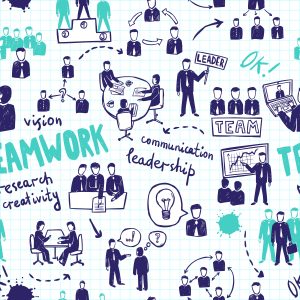The reason why it’s important to include a “People” strategy in your business’ marketing plan is simply because…
Without great people you cannot achieve all of the marketing strategies and activities (the marketing mix) that you have to implement in your overall marketing plan. In other words your business won’t function without a strategy for the people who you recruit and select to support you in running your business and all of its marketing functions. Period!
So let’s start of by defining what this people element of the marketing mix actually is – the strategies and tactics that help you achieve your plans, and then secondly, we’ll take a look at what you really want to achieve through your people.
Definition: “To include all participants who directly or indirectly are involved in the creation, design, development, production, sale and the service packages for your product and service range who offer value in terms of results for customer needs, wants and likes. These include full-time and part-time staff, contractors, franchisees, partners, suppliers, outsourcing agents, volunteers, and associates and referral advocates”.
The aim …is to achieve this definition through the following people strategies and tactics to ensure you have the right marketing and sales input from yourself, your staff and other people who service you to do the right things for your customers.
Here’s how to do this…
People Strategies:
- Ensure that your marketing and sales co-ordination is built into your recruitment and selection procedures
- Then recruit, select, induct, train, coach and support new staff, suppliers and associates towards a marketing focus for all your product and service offers, sales and delivery processes
- Develop your staff in quality innovation and marketing initiatives for new markets, new products, new ways of working and existing and new quality procedures
- Implement individual, team and referral partners in product and service sales training
- Implement performance review systems and re-train as appropriate
People Tactics:
The people part of your marketing mix is vitally important because without people, unless you work on your own …and even then, you’re reliant on someone for providing you with a physical product or a service such as IT. Which means you really cannot perform without great people around you.
People who interact with customers either face-to-face or behind the scenes are the human resource capability with the knowledge, skills and attitude that can give you the competitive advantage in the marketplace – or not, as the case might be.
So, in the final job analysis how good are you really at:
- Recruiting and selecting the right people for the right job
- Making sure they follow your mission, values and vision and work in the correct way by paying attention to the different roles and job demands both offline and online
- Training
- Mentoring and coaching
- Supporting
- Motivating
- Empowering and delegating
- Ensuring customer quality
- Doing things right inside the business (efficiency) and doing the right thing for your customers (effectiveness)
- Creating marketing messages that get attention, keep interest, capture prospect leads and nurture potential customers
- Sales conversions
- Customer delivery and satisfaction
- Referral marketing
You see, the people element of the marketing mix brings together the internal workings of the business and aligns these with external market demands and customer needs, wants and likes. Ultimately this defines the difference between a product, a production or a sales focused business and one with a marketing orientation …one that focuses on engagement along the customer lifecycle journey.
Which means how you plan and set up all aspects of high quality customer contact with your product and service value proposition that you and your people offer to attract, delight and build loyalty with your customers in order to set you apart from your competitors both online and offline.
The Benefits:
- Improves internal efficiency (doing things right) and increases both internal and external customer satisfaction (effectiveness i.e. doing the right thing for customers)
- Provides a framework of best practice to ensure internal communications and team and company development for the achievement of business objectives
- Training (customer delivery and satisfaction) – effective handling of outputs and minimising customer complaints in line with quality processes
- Performance development appraisals whereby employees are continuously motivated, supported and developed on a regular basis through performance reviews to achieve targets with follow-up training, coaching and mentoring support to fill gaps in their knowledge, skills and confidence
- This in turn builds relationships through internal and external communication systems online and offline without creating barriers. It also promotes suggestions for implementing new ideas, new markets and products and new ways of working.

Key Questions:
- How will you install a marketing orientation built into training existing and new staff and for the recruitment and selection processes for future full-time, part-time, contract staff, partners, franchisees and suppliers?
- How will you induct and train new staff in a marketing, sales and customer life cycle service orientation?
- How will you continually reinforce a clear communication of your company mission, identity, values, capabilities and behaviours?





I don’t think the title of your article matches the content lol. Just kidding, mainly because I had some doubts after reading the article.
awesome